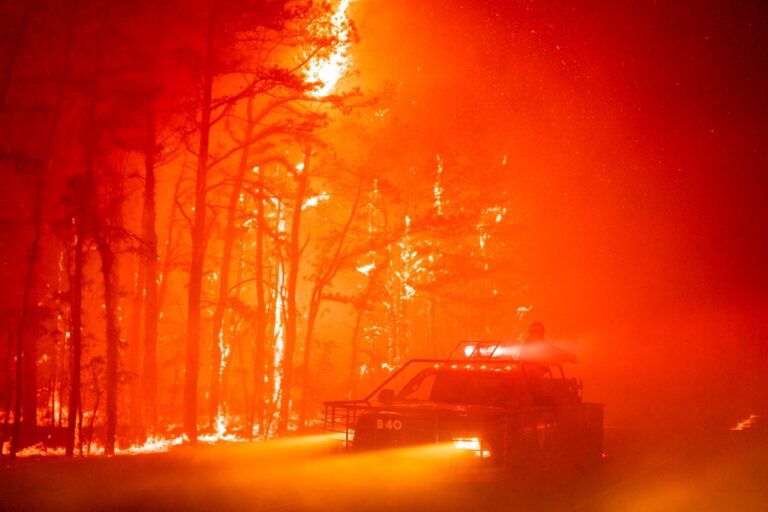A wet winter and cool spring have suppressed wildfire activity across much of the West. Although the area burned nationally remains well below average so far this year, that may begin to change in June. Recent intense heat waves may lead to an early fire season in the Pacific Northwest, which has had a drier than normal winter. Wildfire danger has escalated in Michigan over the past week, while a “hilarious drought” could develop in parts of the Midwest and Northeast.
A sneak preview of the danger facing the Northeast emerged Tuesday as the National Weather Service declared a “critical” fire risk in southeastern Pennsylvania and New Jersey due to low humidity, dryness, gusty winds and the possibility of dry thunderstorms that produce lightning but little rain. The Weather Service believes it is the first time has raised concerns about dry storms in the Northeast.
New Jersey has already seen many fires break out this spring.
A hot and dry Pacific Northwest
Along the northern tier of the West, fuels quickly become more flammable and snow melts quickly.
“Although it is only early June, the vegetation is very dry [due to] the lack of precipitation,” the Weather Service in Seattle he tweeted on Monday. “The fire danger will remain elevated through the middle of the week.”
A red flag warning is in effect for the western slopes of the Cascades until 10 p.m. Tuesday, with increased fire conditions possible across much of Washington.
⚠️Red Flag Warning extended north along the Western Cascades until 10 p.m. this evening due to continued dry conditions. Relative humidity minimums will again drop below 30% this afternoon across much of the region. 🔥#WAwx pic.twitter.com/qX4iEDQdOD
— NWS Seattle (@NWSSeattle) June 6, 2023
Parts of Washington and Oregon saw theirs warmer and drier According to Dan McEvoy, a climatologist at the Desert Research Institute in Reno, Nev.
Snowpack also dropped dramatically in May. areas that started the month with near or above normal snow water content were severely depleted by early June. Increased fire potential is forecast for parts of the Pacific Northwest in September.
Michigan wildfires and fire danger
The Great Lakes states are the primary area of concern for fire danger in June. The high pressure belt that has been plaguing Canada this spring has swung through the region, bringing unusual heat.
Over the weekend, a wildfire near Grayling, Mich., burned about 2,400 acres and forced evacuations. It was 90 percent contained as of Monday, according to the Michigan Department of Natural Resources.
“We've had very little rain the last four weeks,” said Jeff Zoltowski, a meteorologist with the National Weather Service in Gaylord, Mich.
The area is mostly wooded, populated with pines that require fire or prescribed burns to open their cones and release seeds.
“They want to burn … but when it doesn't rain for weeks, that leaves us in a bad spot,” he said.
A red flag warning is in effect until 9 p.m. on Tuesday for parts of lower Michigan, with fire danger remaining high to extreme “throughout the week,” the Weather Service said. Heat, wind and low humidity led to extreme conditions last week across the state.
Fire danger remains extreme across the state and @NWSGaylord has issued a red flag warning. ⁰⁰Be careful out there, don't open yard trash and always have water on hand if you have a camp/cooking fire.
Water, stir and pour again when done. pic.twitter.com/KBP1LBT3tV
— Michigan Department of Natural Resources (@MichiganDNR) June 6, 2023
“If we stay in this dry pattern, it's not just the timber — the grasses can start to dry out or harden,” said Stephen Marien, meteorologist and fire weather program manager for the Eastern Area Coordination Center in St. Louis. Paul, Minn. “I think we're already seeing that — that's what's unusual.”
The landscape is usually lush in early summer with more frequent rainfall from passing weather systems. Fire potential tends to be higher in the spring before the grasses turn green and then again in the fall when leaf litter covers the ground, he said.
“East of the Mississippi, summer is usually our season,” he said.
“Drought” possible in the Midwest and Northeast
According to the latest US Drought Monitor, there was a “huge expansionof unusual dryness in the last week from the Midwest to the Mid-Atlantic and New England. It's a drought expected to develop or worsen in these areas in June.
Some areas of the Midwest, including Michigan, northeast Ohio and parts of Wisconsin, have had less than a quarter of normal precipitation over the past 30 days, while nearly the entire region is below 75 percent of normal, according to Beth Hall. director of the Midwestern Regional Climate Center.
“Technically, a rapid intensification of drought is already occurring in some areas,” he said in an email. “This is attributed to no or very little rainfall over an extended period coinciding with above-normal temperatures and low humidity.”
The culprits are again unusual and persistent high pressure zones in the middle of the continent that prevent any significant moisture influx.
“There are a number of low pressure systems that are going to move into the area, but if the atmosphere stays dry enough, we may not see too many barriers of precipitation and those ridges will come back quickly,” he said.
Conditions in the Mid-Atlantic were as well very dryespecially in Pennsylvania, where some spots saw less than 10 percent of normal precipitation last month.
While the northern margin of the Northeast is projected to see above-normal fire potential in July and August, that fire danger could expand south, shrink, or disappear entirely, depending on summer rainfall.
“The weather east of the Mississippi is more dynamic,” Marien said. “So the outlook for wildfires can change quickly.”
Jason Samenow contributed to this report.

